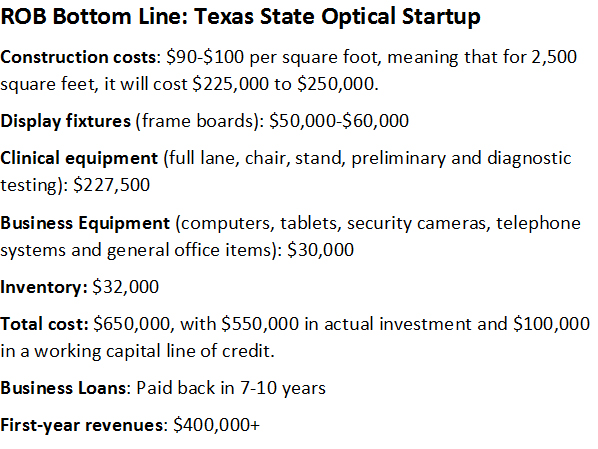By John D. Marvin

June 6, 2018
Starting a practice cold, and making it a profitable success, is daunting. It takes careful financial planning and projection, and the ability to survive until you turn a profit.
As the president of Texas State Optical, a network of independent practices, I’ve seen which start-up practices are likely to succeed, and which are in danger of failing. Over the last 10 years, we’ve helped over 57 start-up practices get profitably up and running.
Having the TSO brand makes the start-up impact that much more effective and successful. One of the big values for young ODs joining TSO is the power and equity in the TSO brand. Consumers already trust us as a provider of eyecare, so when a practice is opened under the umbrella of our brand it is like a known friend, rather than a stranger, moving into the community.
The amount that is needed for a cold start-up is $650,000, with $550,000 in actual investment, and $100,000 in a working capital line of credit. This is the cost of building a 2,500 square foot practice with two examination lanes. There is not a need to go larger for a solo practitioner.
Here’s what I’ve noticed about what’s needed to create a new practice primed for growth and sustainability.
 Assess Needs & How Much Those Needs Will Cost
Assess Needs & How Much Those Needs Will Cost
There are several major costs in starting a new practice.
First is the construction of the new office. This includes the attorney to review and assist in negotiating the lease, the interior designer, architect, the permits and the contractor. All of this will comprise more than 50 percent of the cost of a new start-up practice.
Construction costs are going to run $90 to $100 per square foot depending on the market. This means that for 2,500 square feet, it will cost $225,000 to $250,000.
The second great cost is the clinical equipment. This will account for approximately 35 percent of the total cost of a start-up, or as much as $227,500.
The remaining, large-ticket items are the inventory and the business equipment (computers, tablets, security cameras, telephone systems and general office items). Inventory will likely run as much as $32,000, and office equipment for a start-up can be as much as $30,000.
The best way to manage these expenses is to have experienced, qualified people making the decisions at every step of the process, such as by affiliating with a network like ours, which helps new independent practices get going, or by hiring a consultancy, or experienced business manager, to help.
If you don’t want to affiliate with a network of other independent practices, and you can’t afford a business consultancy or manager, try to connect on your own with other ODs who have started practices cold. You can do this in online communities like ODs on Facebook, on which you could post questions, or even ask for others, who have recently started practices cold, to get in touch with you. You might also connect with other new practice owners by attending optical conferences like Vision Expo East and West.
Create Strategy & Timeline to Profitability
We have a predictable schedule of revenue growth for the practices in our network. Business loans are generally paid back in 7-10 years, and the first-year revenues typically exceed $400,000.
Carrying costs on a loan depends on the lender, but the interest rate should be estimated between 4-5 percent on a ten-year note.
The most important factor in growing revenues is location. You cannot advertise enough to make up for a bad location. The cost that is paid for a good location is largely an advertising expense. You pay for visibility through frequency of traffic. If the location is good, the inventory appropriate, and the staff are trained for a distinct patient experience, then the practice will grow. The only way to properly pick a location is to use a commercial realtor. Don’t try to play realtor yourself.
Another important factor is to keep in mind this is a business you are building, not a personal space that reflects the doctor’s likes and preferences. Everything needs to have a viable, commercial purpose in the practice, or it should not be included. Everything from the design to the decor needs to play a part in the patient experience.
For example, think about how your patients will shop and select their eyewear. Make sure that the frames are well merchandised to make it easy for them to decide on which frame to purchase. If you decide to offer coffee or water, use small cups and the 8 oz bottled water instead of the large. You don’t want people to six and relax, you want them to browse and shop. If you are trying to attract young families, make sure that you have a deep selection of children’s frames and mirrors that are at a height for a six- or seven-year-old.
Experience with optical is ideal, but any good retail, commercial builder can follow a set of blue prints. I would avoid residential contractors. It is important that a full set of construction documents be created from a CAD design plan. The design is most critical. Then it is simply a matter of working with a qualified, commercial contractor.
Introduce Yourself to Your Community–By Pitching In
Another important key to success is involvement in the community by the doctor. The practice owner must be involved and engaged with local business and civic organizations. People do business with, and refer business to, people they know, like and trust. You build these relationships through networking in your community.
Consistent community involvement throughout the first year, at a minimum, is essential. Impact can happen immediately depending on circumstances. The important thing is to get out and create opportunities.
Often doctors think that by joining the Lions Club, Rotary or Chamber of Commerce their business should take off. Membership in these organizations creates the opportunity to build relationships, but in and of themselves will not form those relationships.
Effective community involvement requires a doctor to be outgoing, comfortable with social events, meeting new people, and being interested in them. That is why I recommend that practice owners get involved in organizations they enjoy, so it is more natural for them, and therefore, more likely they will stay involved. That could mean playing on a local softball team, or other sports group, like a bowling league, or even volunteering at the local animal shelter.
The other tip I would give is never to turn anyone, or any organization, down when asked for involvement or support; always say yes. That way people will come to appreciate the practice as an important and generous part of their community.
Create Differentiating Patient Experience
The experience patients have in your office should give them a reason to visit you, versus getting a refraction and purchasing eyewear online, or from a large chain competitor.
Ideally, patients would understand that they should visit an eye doctor in person once a year to assess and safeguard the health of their eyes, but with so much online competition, it’s the satisfaction of the in-person experience in your office, rather than the health benefits alone, that will bring them back.
Differentiating yourself can take many forms. It could mean having frames from independent brands that are hard to find online, including focused one-on-one attention in your optical, in which opticians serve as true style consultants.
Or it could mean having the most advanced eye-health testing and monitoring technology in your area, and an exam-room experience in which you take time to build relationships with patients, getting to know their family history and full lifestyle needs.
It could also mean having a specialty that caters to a particular need, such as a sports-vision specialty, with many sports eyewear products on sale, or a specialty caring for a particular need, like providing services for low-vision patients.
The bottom line: Give patients a reason to choose you, specifically, and make sure every visit to your office is smooth, efficient and as pleasant as a visit to a doctor’s office can be.
 John D. Marvin is the president of Texas State Optical, a network of independent practices that offers support and services to optometrists seeking to start new practices. To contact: jdmarvin@tso.com
John D. Marvin is the president of Texas State Optical, a network of independent practices that offers support and services to optometrists seeking to start new practices. To contact: jdmarvin@tso.com



























